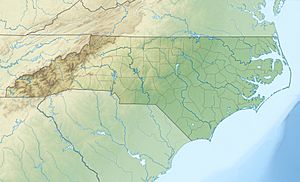Pinch Gut Creek (Brown Creek tributary) facts for kids
Quick facts for kids Pinch Gut Creek |
|
|---|---|
|
Location of Pinch Gut Creek mouth
|
|
| Other name(s) | Tributary to Brown Creek |
| Country | United States |
| State | North Carolina |
| County | Anson |
| Physical characteristics | |
| Main source | divide between Pinch Gut Creek and Little Brown Creek about 5 miles southeast of Polkton, North Carolina 380 ft (120 m) 34°56′31″N 080°09′27″W / 34.94194°N 80.15750°W |
| River mouth | Brown Creek about 1.5 miles east of Polkton, North Carolina 243 ft (74 m) 35°00′58″N 080°09′03″W / 35.01611°N 80.15083°W |
| Length | 5.57 mi (8.96 km) |
| Basin features | |
| Progression | north |
| River system | Pee Dee River |
| Basin size | 8.84 square miles (22.9 km2) |
| Tributaries |
|
| Bridges | Ridge Path Road, US 74 |
Pinch Gut Creek is a small waterway, or creek, located in Anson County, North Carolina, in the United States. It is like a smaller arm of a bigger river system. This creek flows into another, larger creek called Brown Creek.
Contents
Where is Pinch Gut Creek?
Pinch Gut Creek is found in the state of North Carolina. It starts in Anson County, southeast of a town called Polkton, North Carolina. From there, it flows generally south.
Its Journey
The creek travels about 5.57 miles (8.96 kilometers) before it joins Brown Creek. This meeting point is located east of Polkton. Along its path, the creek passes under two roads: Ridge Path Road and US 74.
What is a Watershed?
Every creek and river has something called a watershed or drainage basin. Imagine a big bowl where all the rain and snow that falls within it eventually flows into one main stream or river. That "bowl" is the watershed.
Pinch Gut Creek's Watershed
The watershed for Pinch Gut Creek covers an area of about 8.84 square miles (22.9 square kilometers). This area is mostly covered by forests, making up about 70% of the land. About 23% of the land is used for farming. The rest of the land has other uses.
Why Creeks are Important
Small creeks like Pinch Gut Creek are very important parts of our environment. They help carry water from higher ground to larger rivers and eventually to the ocean. They also provide homes for many plants and animals.
- Creeks help keep the land healthy by moving water.
- They are natural habitats for fish, insects, and other wildlife.
- The plants along the creek banks help prevent soil from washing away.


